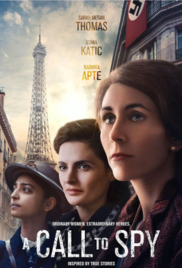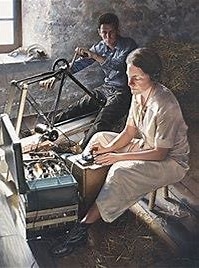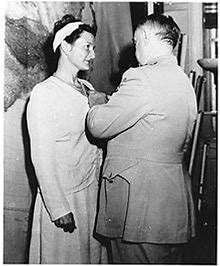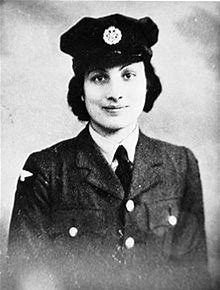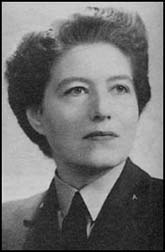Before Watching the Film: To fully appreciate “A Call to Spy,” students should have a general knowledge of the history of World War II. The following is a sample direct instruction to give before showing the film.
World War II began in 1939 with the German invasion of Poland. Nazi forces swiftly conquered Austria, Denmark, Norway, Czechoslovakia, Belgium, the Netherlands, Luxembourg, Yugoslavia, and Greece.
France, expected to be a bulwark against the German army, collapsed in June of 1940. The victorious Nazis divided France into two zones: one in the North and West of the country, which was administered as an occupied territory, and the other in the South and Southeast, which was governed by a fascist government administered by Frenchmen but subservient to the Germans. This government was headquartered in a town called Vichy, and the area that it governed is called “Vichy France.”
After the fall of France in June 1940, the only thing that separated Britain from the Nazi armies was the English Channel, which was only 21 miles wide at its narrowest width. If Britain were to fall, the Nazis would control the entire continent of Europe.
At the beginning of the war, Britain lacked the military capacity to turn back the German conquests on the European mainland. The British therefore adopted a three-pronged approach to the war: a naval blockade of Europe, aerial bombing, and sabotage in the occupied nations. A month after France fell, Britain established the Special Operations Executive (SOE) to conduct its espionage campaign and, as Prime Minister Winston Churchill ordered, to “set Europe ablaze.”
The film provides reasonably accurate portrayals of a number of people who participated in the struggle over France in WW II. They are Virginia Hall, Vera Atkins, Maurice Buckmaster, Noor Inayat Khan, Dr. Jean Rousset, Father Robert Alesch, Klaus Barbie, and “Wild Bill” Donovan.
Virginia Hall was an American woman who spent much of her youth in Europe and wanted to work as a foreign service officer for the U.S. Department of State. However, at the age of 27, she lost the lower part of her left leg to a hunting accident. When she recovered, Ms. Hall was fitted with a prosthetic leg. At the time, the State Department hired few women and was not about to hire a woman with an artificial limb. Ms. Hall’s repeated applications to be a foreign service officer were turned down.
Desiring to be of service, loving France, and hating the Nazis, Ms. Hall, served as a volunteer ambulance driver for the French Army. After the Nazi victory in 1940, Ms. Hall went to England where she joined the British Special Operations Executive (SOE). She was infiltrated into Vichy France and worked undercover for more than a year. During that time she successfully developed a network of resistance fighters and provided them with money and weapons. When her first network was betrayed by a corrupt priest named Robert Alesch, Ms. Hall escaped to England just one step ahead of the Gestapo. To do this she had to make a harrowing trek across the Pyrenees Mountains, an effort that had proved impossible for some people who had the use of both of their legs.
The SOE thought it was too dangerous to send Ms. Hall back to France, now fully occupied by the Germans. The American had by then joined the war, and Ms. Hall volunteered to work for the U.S. Office of Strategic Services (OSS), the predecessor of the CIA. Returning to France for the OSS, Ms. Hall developed, funded and armed networks of resistance fighters and engaged in acts of sabotage that so damaged the Nazi war machine that the Germans were expelled from the Haute-Loire Department (an administrative division of the French state slightly larger than Rhode Island) before the arrival of the Allied armies.
There is a reference in the film to the “Jedburgh teams.” These usually consisted of three agents, one from the American OSS, another from the British SOE, and a third from the country into which they were to be parachuted. The goal of the Jedburgh teams was to provide leadership to resistance forces and coordinate with the Allied armies.
Franklyn D. Roosevelt was president of the United States from 1933 until 1945. He led the U.S. out of the Great Depression and to victory in WW II. He was crippled with polio from the age of 39 but did not allow his disability to prevent him from running for office.
Vera Atkins was a Jewish refugee from Romania. Before the end of WW II, anti-Semitism was rife in Europe and present to a lesser degree in Great Britain and the United States. Vera Atkins worked for the SOE recruiting and handling their female agents. She faced distrust by her co-workers at SOE because she was from Romania, a state allied with the Germans in WW II, and because she was Jewish. However, she was always supported by Maurice Buckmaster, head of the SOE F (France) Section. [This last will help set up the anti-Semitic comments in the party scene where Virginia Hall and Vera Atkins meet for the first time.]
There are scenes in the movie in which Virginia Hall takes Benzedrine, an amphetamine, given to her by her handler at the SOE, Vera Atkins. It wasn’t until after WW II that people learned that speed could cause addiction. Fortunately, Ms. Hall did not get addicted to Benzedrine. (Remember, the speed that you get on the street or from friends, even if they say it is prescribed medication, can contain fentanyl that has killed many people who took only one pill or less.) The film also shows many people smoking. During WW II, the fact that smoking caused lung cancer and heart disease was not generally known.

